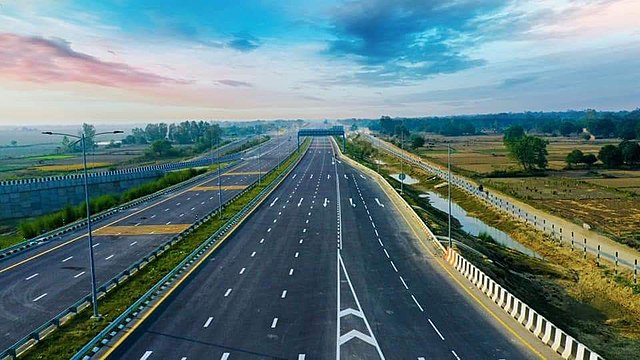Overview:
India ranks second in the world with the largest road network, spanning a total of 5.89 million kilometres (kms). This road network helps in the transport of 64.5% of all goods in the country and is used by 90% of India’s total passenger traffic to commute from one place to other. Road transportation has gradually increased over the years with improvement in connectivity between cities, towns and villages in the country.
The total stretch of road network as per the data of 2021-22 in IBEF is around 6,371,847 kms. With such a large stretch, the road network in India has been sub divided into 3 categories:
- State highways: The share of state highways is 2.6% of the total roads in India with total length is around 171,039 kms
- National highways : National highways holds 2.21% of the total roads in India. Its total length is 140,995 kms
- Other roads: This category of roads comprises of the largest road network in India with a share of around 95% of the total roads in India. It’s total length is around 60,59,813 kms
Policy Support by Government of India:
India has been included to a global alliance of 15 countries that will cooperate to promote the ethical use of smart city technologies. The government plans to build 65,000 kilometres of national highways for Rs. 5.35 lakh crore (US$ 741.51 billion). By 2025, the government plans to build 23 new national highways. Andhra Pradesh would invest US$ 296.05 million in the construction of 8,970 kilometres of roads. NHAI announced a plan in February 2022 to build 5,795 kilometres of highways connecting 117 districts. The proposal had a value of Rs. 1 trillion ($13.09 billion).
Road building in India is second least expensive in Asia. There has been increase in the investment made in this sector. PPP participation is increasing. As of March 2022, the transfer from the National Investment Fund (NIF) was anticipated to be Rs. 20,000 crore (US$ 2.61 billion). As of July 2021, the government had invested US$ 1.4 trillion in infrastructure development (NIP) through the National Infrastructure Pipeline.
The government released a notification in October 2021 regarding concessions under the Vehicle Scrapping Policy (effective April 2022) to encourage vehicle owners to get rid of obsolete vehicles that consume more fuel. The Central Roads and Infrastructure Fund Act was amended by the Finance Bill 2019. Criteria for any state road project will now be developed by the federal government.
In FY21, 13,298 kilometres of highway were built in India. In January 2022, the sale of domestic passenger vehicle of three-wheelers and two-wheelers totaled 254,287,24,091 and 1,128,293 units, respectively. In FY22 (until October), the Ministry of Road Transport and Highways constructed national highways extending 4,450 kms.The Minister for Road Transport & Highways, Mr. Nitin Gadkari, is targeting to construct 40 kms per day in FY22. In order to boost the industry, the Government of India has also planned to cut the GST rate on construction equipment from 28% to 18%.
Over the years, setting up proper road infrastructure has been the key focus during the budget allocation. The Ministry of Road Transport and Highways has been given Rs. 199,107.71 crores (US$ 26.04 billion) in the Union Budget 2022-23. The rise in the Union Budget for 2022-23 was a stunning 68 percent over the previous year. The government plans to finish 25,000 kilometers of national roadways in the Union Budget for 2022-23. Mr. Nitin Gadkari, the Union Minister for Road Transport and Highways, lay the foundation stone for 16 National Highway projects in Manipur in July 2021. These projects will cost $556.67 million to construct and will span 298 kilometers.

Source: Ministry of External Affairs, Economic Survey-2019-20, MoRTH, News Articles
Public sector enterprises controlled the road construction market until 2005. The road-building business has become fragmented and competitive as private players have emerged during the previous decade. The scale of the players bidding on projects varies as well. The Public Private Partnership (PPP) in road infrastructure projects has increased in recent years. There were 125 PPP projects worth US$ 23.25 billion in India in FY21.

Source: MoRTH, Department of Economic Affairs, News Articles
Government Initiative:
- Rural development : According to the Union Budget 2019-20, 30,000 kilometres of PMGSY roads were constructed utilising green technology, waste plastic, and cold mix technology, lowering carbon emissions. The Government of India has allotted Rs. 19,500 crore (US$ 2.79 billion) for Pradhan Mantri Gram Sadak Yojana in the Union Budget 2020-21. (PMGSY)
- Focus on improved safety standards: The government announced plans to increase road safety in October 2021, including mandatory sleep detection sensors in commercial vehicles and fixed driving hours for commercial truck drivers.
- Taxes and other sops : For the first five years, companies receive a 100% tax exemption on road construction, followed by a 30% reduction for the next five years. To improve viability, companies have been given up to 40% of the entire project cost in capital.
- International tie-ups • The Ministry of Road Transport and Highways signed an MoU with the Federal Ministry of Climate Action, Environment, Energy, Mobility, Innovation and Technology of the Republic of Austria in December 2020 for the technology cooperation in the road infrastructure sector.
- Encouragement of infrastructure debt funds (IDFs) : Encouragement of infrastructure debt funds (IDFs): The India Infrastructure Finance Company (IIFCL) was established by the Indian government to provide long-term funding for infrastructure projects. Interest payments on external commercial borrowings for infrastructure are now subject to a 5% withholding tax rather than the previous 20%, while IDF income is tax-free.
- Gati Shakti-National Master Plan: The Indian government announced the Gati Shakti-National Master Plan, which will aid in the development of infrastructure in a holistic and integrated manner, creating a large number of job possibilities in the country. The plan’s goal is to create a digital platform that will allow 16 ministries to collaborate on integrated project planning and implementation. The plan will also bring together departments like as railways, roads and highways, and others, with geo-satellite imaging and Big Data, land, and logistics being used to achieve it. The Gati Shakti programme in India has compiled a list of 81 high-impact projects, with road infrastructure projects ranking first. The major goal of this programme is to provide a speedier approval procedure that can be completed through the Gati shakti portal, which has totally digitised the approval process.
- Motor Vehicle Aggregator Guideline: The Ministry of Road Transport and Highways announced the ‘Motor Vehicle Aggregator Guidelines 2020’ in November 2020 to govern shared mobility and alleviate traffic congestion and pollution.
Key Challenges:
- Land acquisition has been one of the significant challenge faced by the road and transport industry. Land acquisition can cost at least 25% to 30% of a project’s total cost; in some cases, it can even exceed the cost of construction. It not only raises project expenses but also causes significant delays. IIn a research undertaken by NHAI on 106 projects worth over 1.5 billion dollars that were facing implementation delays, land acquisition challenges were identified as one of the major causes of delay in nearly half of the projects. Furthermore, around 5% of these projects were delayed solely due to land acquisition concerns.
- Mobilising of raw materials: Because the majority of the projects are built in remote locations, mobilising equipment and raw materials will be difficult. A number of steps, including raising the NHAI’s project clearance limit to Rs 2,000 crore from Rs 1,000 crore, increasing farmer compensation rates under the new land purchase policy, and digitising land acquisitions, will speed up projects under Bharatmala.
- Lesser Private sector involvement: There is very little private sector involvement in the construction of new roads and motorways. This is due to the developers’ financial profile, a shortage of debt products that may be connected to highway revenue models, as well as delays in land acquisition and an uncertain regulatory framework. With significant change in the Government’s policies, the private sector involvement has significantly increased in recent years.
Conclusion:
The government is working on strategies to encourage considerable investment interest through a number of initiatives. By 2022, 200,000 kilometres of national highways are projected to be finished. The National Highway Authority of India (NHAI) would be able to raise Rs. 1 lakh crore (US$ 14.30 billion) each year from tolls and other sources in the next five years. In 2022, India’s road sector will experience enormous growth as additional stretches of national highways are built, and several projects and fundraises are granted and completed, making it a better year than the previous one. According to Road Transport Secretary Giridhar Aramane, the 2022 radar will also see an integrated multi-modal national network of transportation and logistics, connectivity with remote and difficult terrains, decongestion of key points on the road network, and progress with the voluntary vehicle scrappage policy. Ministry of Road Transport and Highways, Nitin Gadkari has said that by December 2024, Indian roads and highways will be at par in excellence with those of United States. With strong vision and improved technologies and policies, Government is planning to completely change the road network in India to bring down the cost of logistics and boost the economy. This year Government is planning to build 50 kms of highways per day, exceeding its previously completed target of 38 kms per day which has been a World record.
Strong transportation infrastructure is ultimately necessary for economic prosperity. One of the most crucial pillars in India’s rapid economic recovery will be a strong road network, and one would expect that the government’s budgetary commitment to improving roadway infrastructure is matched by attractive private investment opportunities in the sector.








